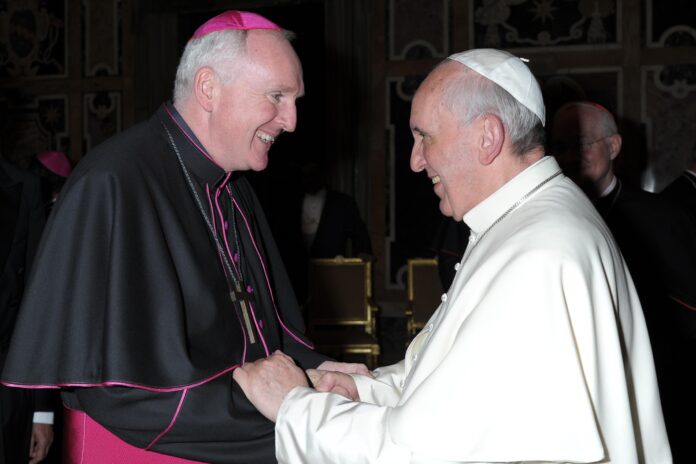
Bishop of Limerick, Brendan Leahy, reflects on the passing of Pope Francis and his personal meetings with the late Pontiff.
Many have commented on the images of the sheer beauty of the setting of Pope Francis’s funeral along with the amazing image of Presidents Trump and Zelensky sitting in conversation together.
Peace radiated from the beauty of the liturgy. But at a time of toxic relationships in world politics, there was also peace in the thought that maybe, now praying for us from above, Pope Francis was working a small miracle of peace. And that in doing so he wanted to remind us to guard and live the legacy he left us – the promotion of a holistic peace by fostering a culture of encounter and listening at every level through care for the marginalised, care for the planet and care for our world slipping into a world war piecemeal.
I was driving when I heard the news of his death on the radio on Easter Monday. I found myself recalling an expression that I had heard older people in West Kerry use: “turus roimh bás”, a “journey before death”.

- External Walls: Up to €8,000 Grant
- Attic: Up to €1,500 Grant
- Cavity Walls: Up to €1,700 Grant
- Internal Dry Lining: Up to €4,500 Grant
There was this experience often noticed that someone elderly, ailing in ill health, would suddenly take to visit their neighbours and then die shortly afterwards. They were preparing themselves for the final journey. Was that what Pope Francis was doing on the previous day, Easter Sunday, when, though very feeble, he greeted the city and the world for the last time?
For the past 12 years, Pope Francis has been journeying with us. He was a major public figure, often called the “conscience” of the world, a prophet, someone prepared to call out situations of injustice, abuse of all kind, and plundering of the earth. But more than his words, which were so striking and full of spiritual and human impact, he was a man of prophetic gestures – spontaneously embracing a man he met in St Peter’s Square with severe skin deformity (the Pope couldn’t have known whether the condition was contagious), sitting down to lunch regularly with the homeless of Rome, welcoming prostitutes, LGBTQ+ people to his residence, breaking through protocols to be near people like during the treacherous trip to Central Africa entering a mosque under siege from armed Christian militias in Bangui.
It’s hard to believe that it was only last September that, at 87 years of age, Pope Francis travelled to East Asia, visiting countries with totally different profiles and time zones – Indonesia, Papua New Guinea, Timore-Leste, and Singapore.
A prophetic public figure
For Catholics, of course, the Pope is not just a prophetic public figure. He has a charism or gift from the Holy Spirit that has to do with our faith and spiritual life. What a gift Pope Francis has been for us.
Rivers of spiritual wisdom have flowed out from his life and teachings regarding the importance of mercy, the significance of welcoming the marginalized (we think of his words during the Lisbon World Youth Day in 2023: “todos, todos, todos”, “everyone, everyone, everyone”), the need for personal conversion in holiness, the vision of Christian faith as a journey to be lived and discerned together in synodality (the Church isn’t an NGO or a network of scattered individuals!), the call to a more holistic living out of the Church’s moral teachings regarding sexuality and family life.
I have a wonderfully personal recollection of a lunch with the Pope a few years ago in Santa Marta. He engaged in conversation but never dominated and yet was keenly interested in what I and others at table had to say.
While I was speaking about Ireland, he offered his view that it has been particularly our increasing prosperity that has led to many of our changing religious values.
Pope Francis’ visit to Ireland in 2018 for the World Meeting of Families was memorable. We think of the wonderful atmosphere in Croke Park as he listened to the testimony of family life from around the world. We know he came tired, having had a gruelling schedule that day, not least from spending much time in listening to victims/survivors of abuse that led him spontaneously to draft a strong statement of apology and condemnation of all forms of abuse that he read out at the Mass in the Phoenix Park the following day.
Just last October, I had the privilege of meeting him several times during the Synod in Rome on synodality. He arrived each morning without any fanfare and simply went to his table and any of us could approach him. He was simply there to listen, enjoy meeting up, and express his good humour.
Those of us on the recent Limerick Diocesan pilgrimage at the end of March will always treasure our moment of seeing him and receiving his blessing as he left the Gemelli hospital on March 23.
There he was, a living icon of the hope that spurs us on no matter what adversities we meet.
Little did we realise he was beginning his “turus roimh bás” that day, concluding his 12-year journey with us that has certainly brought Catholics and many others besides a good distance along our own personal journey of faith, hope, and love.

